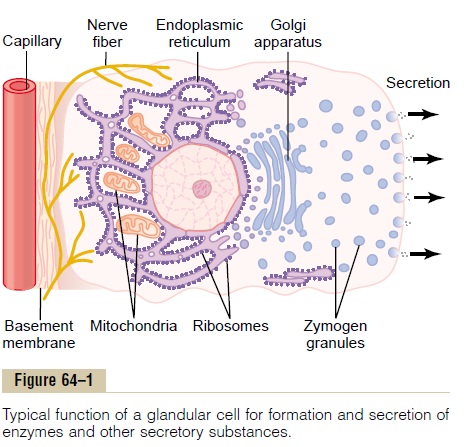Chapter: Medical Physiology: Secretory Functions of the Alimentary Tract
Basic Mechanism of Secretion by Glandular Cells

Basic Mechanism of Secretion by Glandular Cells
Secretion of Organic Substances. Although all thebasic mechanisms by which glandular cells function are not known, experimental evidence points to the following principles of secretion, as shown in Figure 64–1.

1.The nutrient material needed for formation of the secretion must first diffuse or be actively transported by the blood in the capillaries into the base of the glandular cell.
2.Many mitochondria located inside the glandular cell near its base use oxidative energy to form adenosine triphosphate (ATP).
3.Energy from the ATP, along with appropriate substrates provided by the nutrients, is then used to synthesize the organic secretory substances; this synthesis occurs almost entirely in the endoplasmic reticulum and Golgi complex of theglandular cell. Ribosomesadherent to the reticulum are specifically responsible for formation of the proteins that are secreted.
4.The secretory materials are transported through the tubules of the endoplasmic reticulum, passing in about 20 minutes all the way to the vesicles of the Golgi complex.
5.In the Golgi complex, the materials are modified, added to, concentrated, and discharged into the cytoplasm in the form of secretory vesicles, which are stored in the apical ends of the secretory cells.
6.These vesicles remain stored until nervous or hormonal control signals cause the cells to extrude the vesicular contents through the cells’ surface. This probably occurs in the following way: The control signal first increases the cellmembrane permeability to calcium ions, andcalcium enters the cell. The calcium in turn causes many of the vesicles to fuse with the apical cell membrane. Then the apical cell membrane breaks open, thus emptying the vesicles to the exterior; this process is called exocytosis.
Water and Electrolyte Secretion. A second necessity forglandular secretion is secretion of sufficient water and electrolytes to go along with the organic substances. The following is a postulated method by which nervous stimulation causes water and salts to pass through the glandular cells in great profusion, washing the organic substances through the secretory border of the cells at the same time:
1.Nerve stimulation has a specific effect on the basal portion of the cell membrane to cause activetransport of chloride ions to the cell interior.
2.The resulting increase in electronegativity induced inside the cell by excess negatively charged chloride ions then causes positive ions such as sodium ions also to move through the cellmembrane to the interior of the cell.
3.Now, the new excess of both negative and positive ions inside the cell creates an osmotic force that causes osmosis of water to the interior, thereby increasing cell volume and hydrostatic pressure inside the cell, causing the cell itself to swell.
4.The pressure in the cell then initiates minute openings of the secretory border of the cell, causing flushing of water, electrolytes, and organic materials out of the secretory end of the glandular cell.
In support of these secretory processes have been the following findings: First, the nerve endings on glan-dular cells are principally on the bases of the cells. Second, microelectrode studies show that the normal electrical potential across the membrane at the base of the cell is between 30 and 40 millivolts, with negativ-ity on the interior and positivity on the exterior. Parasympathetic stimulation increases this polariza-tion voltage to values some 10 and 20 millivolts more negative than normal. This increase in polarization voltage lasts for 1 second or longer after the nerve signal has arrived, indicating that it is caused by move-ment of negative ions (presumably chloride ions) through the membrane to the interior of the cell, thus leading to secretion.
Although this mechanism for secretion is still partly theoretical, it does explain how it would be possible for nerve impulses to regulate secretion. Hormones acting on the cell membrane are believed also to cause similar secretory results to those caused by nervous stimulation.
Related Topics